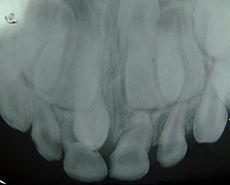- Hyperdontia
-
Hyperdontia Classification and external resources 
Supernumerary teeth at premaxillary areaICD-10 K00.1 ICD-9 520.1 MeSH D014096 Hyperdontia is the condition of having supernumerary teeth, or teeth which appear in addition to the regular number of teeth.
Contents
Types
Supernumerary teeth can be classified by shape and by position. The shapes include:
- Supplemental (where the tooth has a normal shape for the teeth in that series);
- Tuberculate (also called "barrel shaped");
- Conical (also called "peg shaped");
- Compound odontome (multiple small tooth-like forms);
- Complex odontome (a disorganized mass of dental tissue)[1]
When classified by position, a supernumerary tooth may be referred to as a mesiodens, a paramolar, or a distomolar.[1]
The most common supernumerary tooth is a mesiodens, which is a mal-formed, peg-like tooth that occurs between the maxillary central incisors.
Fourth and fifth molars that form behind the third molars are another kind of supernumerary teeth. [2]
Causes
There is evidence of hereditary factors along with some evidence of environmental factors leading to this condition. Many supernumerary teeth never erupt, but they may delay eruption of nearby teeth or cause other dental problems. Molar-type extra teeth are the rarest form. Dental X-rays are often used to diagnose Hyperdontia.
It is suggested that supernumerary teeth develop from a second tooth bud arising from the dental lamina near the regular tooth bud or possibly from splitting the regular tooth bud itself. Supernumerary teeth in deciduous (baby) teeth are less common than in permanent teeth.
Related conditions
A similar condition is hypodontia, in which there are fewer than the usual number of teeth.
Hyperdontia is seen in a number of disorders, including Gardner's syndrome and cleidocranial dysostosis where multiple supernumerary teeth are seen that are usually impacted.
References
- ^ a b Oxford Handbook of Clinical Dentistry
- ^ Kokten G, Balcioglu H, Buyukertan M. Supernumerary Fourth and Fifth Molars: A Report of Two Cases. Journal of Contemporary Dental Practice, 2003 November; (4)4:067-076. Page accessed December 13, 2010.
External links
- Tooth Conditions and Abnormalities at mchoralhealth.org
Developmental tooth disease/tooth abnormality (K00–K01, 520) Quantity Abnormalities of
size and formConcrescence · Fusion · Gemination · Dens evaginatus/Talon cusp · Dens invaginatus · Enamel pearl · Macrodontia · Microdontia · Taurodontism · Supernumerary rootsDisturbances in
formationOther hereditary disturbances
in structureOther Categories:- Developmental tooth disorders
- Supernumerary body parts
- Diseases of oral cavity, salivary glands and jaws
Wikimedia Foundation. 2010.
